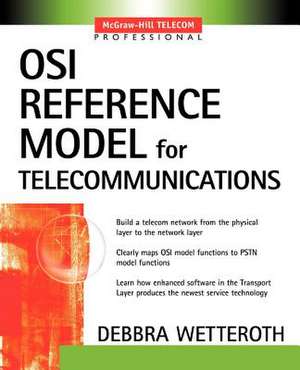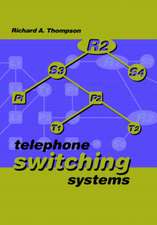OSI Reference Model for Telecommunications: McGraw-Hill Telecom Professional
Autor Debbra Wetterothen Limba Engleză Paperback – 31 oct 2001
Preț: 358.69 lei
Nou
68.66€ • 74.60$ • 57.71£
Carte tipărită la comandă
Livrare economică 21 aprilie-05 mai
Specificații
ISBN-10: 0071380418
Pagini: 396
Ilustrații: 1
Dimensiuni: 186 x 233 x 27 mm
Greutate: 0.69 kg
Editura: McGraw-Hill Professional Publishing
Seria McGraw-Hill Telecom Professional
Textul de pe ultima copertă
HERE'S STRAIGHTFORWARD EXPLANATIONS OF THE OSI LAYERS AND THEIR RELATIONSHIP TO TELECOM SERVICE AND EQUIPMENT. WHETHER YOU NEED ANWERS ON HARDWARE, SOFTWARE, ERROR CONTROL OR INTERFACES, LOOK INSIDE FOR BASIC FACTS AND HOW TO MANAGE THOSE CRITICAL "SPECIAL CIRCUMSTANCES"
The OSI (Open System Interconnection) Reference Model is a cornerstone of modern network design. Although the OSI model has become almost synonymous with data communications, it serves the public switched telephone network (PSTN) as well and is a productive way to organize and teach the building blocks of telecom systems.
In OSI Reference Model for Telecommunications, hands-on expert Debbra Wetteroth provides telecom staffers the information they need to gain a working knowledge of this essential telecom service architecture and equipment. Her style that breaks down the barriers between data and voice vocabularies. This quick reference to the OSI model puts the data you need everyday at your fingertips.
Look inside for an understandable schematics of:
* Mapping PSTN functions to OSI
* The basics of successful data transmissions
* What OSI is and does
* The components that make up OSI
* OSI "common knowledge" (the kind that's not always so common), such as numbering system, signaling rates, and noise distortion data
* A detailed description of Layers 1 to 3 and a thorough review of the Transport Layer. For each layer, you'll learn roles, functions, definitions, and more
This unique volume will prove invaluable to telecommunications technicians, field supervisors, switch managers, network analysts, network designers, and anyone else who needs detailedexplanation of the many components of OSI.
























